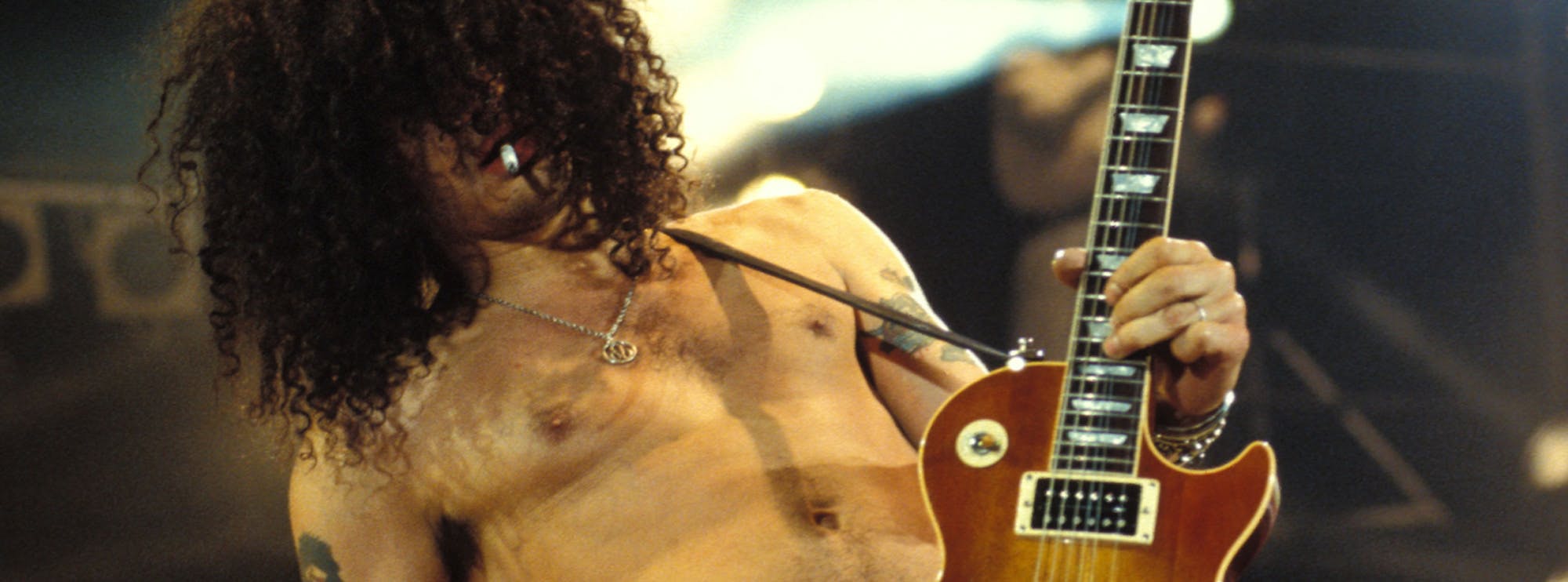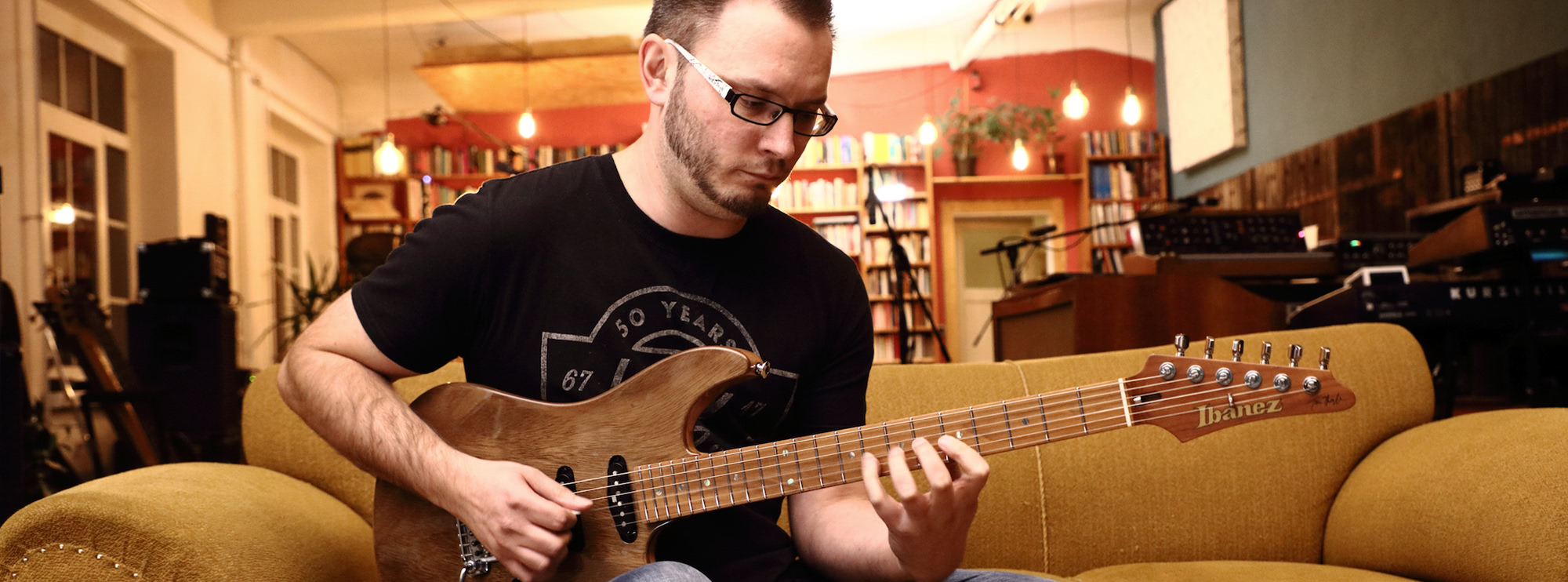Rising to prominence in 1988 as the sideman for Ozzy Osbourne, Zakk’s ferocious pentatonic-based playing stood in stark contrast to the neo-classical shredders of the age.
Nick Jennison
GENERAL PRELIMINARY GUIDANCE
While Zakk’s vocabulary is undoubtedly distinctive, his style is less about what’s being played and more about how it’s being played. Keep the following in mind as you go forward.
Perhaps the most immediately recognisable aspect of Zakk’s playing is that monstrous vibrato. Moderate in speed, the intensity comes from the sheer width. A tone in width at the very least, Zakk’s vibrato is often a tone and a half wide (that’s three frets). Be careful with your muting, and unless you’re also a man-mountain with hands to match, consider light strings!
Zakk’s right-hand touch is often a lot lighter than you might imagine. Picked runs are certainly aggressive, but those howling sustained notes require a more deft approach. The best way to achieve this is by relaxing the right-hand index-finger-and-thumb assembly to allow the pick to “brush” the strings.
On the subject of brushing the strings, the flesh of Zakk’s right-hand index finger and thumb will usually slightly graze the strings as he picks. This is critical for creating that signature “meow-ing” tone, but it also helps with gauging the depth of the pick on the strings - especially useful with using the larger, elbow-driven picking movements Zakk is known for.
PICKING
It probably hasn’t escaped your attention that Zakk is a phenomenal picker. His accuracy, tone and intensity are pretty remarkable. His technique is actually quite unusual, and if you’re interested in authentically reproducing his style, you’ll have to get on board with it.
Zakk’s faster picking lines are usually elbow-driven (rather than wrist-based). Contrary to what some would have you believe, there’s absolutely nothing wrong with picking from the elbow - it’s actually one of the fastest ways you can move the pick!
Zakk is a pretty strict downward pickslanter (see the video for a more detailed explanation). This is most likely a product of the way he wears his guitar, which is low enough to make Jimmy Page blush. The upshot of this is that upstrokes are free to move from string to string, but downstrokes require some special attention.
“Swiping” is a big part of Zakk’s string change strategy when moving to a new string after a downstroke. See the video for a more detailed breakdown, but be aware that a relaxed pick grip is what makes this work.
With all that that in mind, let’s stuck in!
BARS 1-4:
We begin with a rather nasty sounding semitone figure. This sort of line is one of the few times you’ll see Zakk performing some subtle vibrato, as you shake the B string note to create a clashing texture against the static E string note. Kick on a Uni-Vibe type effect (Zakk uses a Dunlop Rotovibe) for extra eeriness!
BARS 5-11:
We launch into a crushing drop D riff (inspired by 2000s Ozzy) with a big slide, which you can use to mask turning off your Vibe. The pinched harmonics on the low string need to scream and not “ping” - a lighter attack will really help with this.
BAR 12:
A Hendrix-inspired exchange bend - use your second finger to grab the g string as the b string goes up. Huge vibrato on the last note of this phrase is a necessity!
BARS 13-19:
There are a few quirks that make this BLS-inspired riff tick. First are the semi-harmonics on the low string. These aren’t fully-fledged pinches, but the execution is similar. Start with the pick close to the bridge and move it gradually towards the neck. Big vibrato on the D7#9 chords will keep things nice and aggressive. Lock your fingers in place and move the whole left forearm to get the desired effect. Lastly, the rakes behind the bridge can be replicated on a guitar without a tune-o-matic by holding a 2nd fret natural harmonic and raking across the E to D strings.
BAR 20:
A classic downward pickslanting pentatonic lick to kick off the first solo, which is inspired by Zakk’s work with Ozzy Osbourne. Bury your pick in the strings on the downstrokes, and let it rise up on the upstrokes. It’s an efficient way to play this kind of line with the kind of rock-solid timing that characterises Zakk’s pentatonic work.
BARS 21-24:
Starting out with some sweeping unison bends, this passage quickly moves into a descending version of the lick in bar 20. The same principles apply here. Use a sneaky pull-off on the D string to give yourself time to get into position for the “chicken-pickin'” idea that closes out this phrase.
BARS 25-26:
This four-note figure is very common in Zakk’s faster playing, and once you have the mechanics down, it’s surprisingly easy to carry off. Use your second finger to fret the G string notes, and concentrate on getting the upstroke on the B string in time with your left hand - the rest should take care of itself.
BAR 27:
Another downward pickslanting pentatonic lick. Don’t worry about sticking rigidly to the quintuplet rhythm - as long as you get all the notes in before the next bar; everything will be fine.
BARS 28:
A fun little trick for creating Whammy-type effects on a stoptail guitar. Slide down the g string with your right hand, while hammering and pulling off with your left hand. Try to stay about 2 frets above the right hand with the left, but don’t worry too much about being entirely accurate with this one.
BARS 29-36:
Switch your overdrive pedal off and your chorus on for some sombre BLS-inspired balladry. The chord changes can be a little tricky and require some tidy left-hand fingering. Get right up on the tips of your fingers to make sure everything rings out as it should.
BARS 37-41:
Soaring melodic leads are a big part of Zakk’s repertoire, and that’s the vibe we’re going for in the second solo. Be sure not to overcook the right hand with this one - a gentler touch will let the notes bloom an sing. These slower passages also give plenty of time to use the right-hand thumb and fingers to mute adjacent strings when using super wide vibrato.
BARS 42-44:
Ramping up the drama with some Schenker/Moore inspired blues lines. You can pick the faster notes pretty hard, but ease up on the sustained notes to let the vibrato sing. The faster passage in bars 43-44 can actually benefit from being a little scrappy - too tidy, and there’s no sense of danger. Be aggressive, and consider the lick in the transcription a “guideline” rather than an absolute instruction.
BARS 45-48:
Howling bends in the vein of fellow Les Paul slinger John Sykes, be quick on the way up and slow on the way down, with the most intense wailing vibrato you can muster. Kossoff would be proud!
BARS 49-50:
We’re firmly back in Ozzy territory with this No More Tears inspired passage. In stark contrast to bar 44, this has to be perfectly clean and in time to achieve the desired effect. Get your downward pickslanting happening, and consider a little gentle palm muting on the d string notes for added tightness.
BARS 51-21:
We’re making use of the four-note mechanic from bars 25-26 to create some dramatic arpeggio furries at the climax of this second solo. The bend at the end should be short and fast so that you can get back into the riff as quickly as possible.
BARS 53-59:
The same riff that we opened with get those legs spread wide, and if you’ve got the hair for it, bang that head! Or use this time to catch your breath - things are about to get a bit shreddy!
BAR 60:
The third solo is inspired by Zakk’s more recent work with BLS. When he’s not behaving himself with Ozzy, Zakk’s playing can be downright vulgar! Stomp on your wah to really set things off.
This is also where we start to see Zakk’s swiping mechanic in action. This section is still downward pickslanting all the way, but the outside string changes on the a-to-d strings and d-to-g strings are accomplished by simply battering through the muted higher string on the downstroke. If you keep your pick grip relaxed but apply plenty of force from the elbow, it should sound completely clean! These changes are marked with an (x) on the tab.
BAR 61:
More swiping here, including some tricky two-string swipes. Make the upstrokes on the higher strings your focus, and keep the grip loose. Although this is an example of Zakk’s Al Di Meola in-fluence, Al would achieve this same line very differently. If you can’t make the swiping work for you, you can still carry this lick off using two-way pickslanting like Al would.
BARS 62-64:
A monstrous flurry of alternate picked notes, don’t worry if things get a little garbled at times - it only adds to the excitement. Some notes are doubled up to facilitate the picking more easily, and there are swipes galore! We’re not trying to be John Petrucci here - keep it intense, and consider the tab a “guideline”.
BARS 65-66:
Some intense “chicken-pickin'” around a nasty sounding flat 5 note. Don’t sweat the exact timing here - just go as fast as you can manage, and make sure you get that double stop idea in on beat 2 of bar 66 to bring the whole thing back into step. Use the ring and middle fingers on tour right hand and roll your left-hand pinky finger to execute the country style pedal steel lick, pre-bending the g string note as you do.
BARS 67-68:
Just when you thought things had gone completely off the deep end, we bring everything back home with something bluesy! Zakk has a tenancy to finish his solos with more “tasteful” ideas like this, and that’s something we can all learn from. Grab the b string as you re-pick the last bend, and over-bend like crazy!
BARS 69-75:
Home stretch now, and I’m not ashamed to say that this fourth solo was inspired by Zakk’s work on the Rock Star soundtrack! Give the lower string on the unison bends and some heavy vibrato, but don’t worry about going as far as a tone - just enough to make them “crackle”. The lick in bar 74 is best thought of as “trilling and tremolo picking at the same time”, and is a John Sykes main-stay. Move both hands as fast as you can and concentrate on the downbeats - things have a habit of syncing up nicely if you do.
BARS 76-84:
We couldn’t look at Zakk’s playing without exploring his country and southern rock influences, and this final solo is inspired by some of his best-loved playing with Pride & Glory, with nods to Ozzy mega-ballad Mama I’m Comin’ Home. Keep things strictly in time, and back the intensity down just a little.
The pedal steel bend that kicks things off is the same as the one found in bar 66, but slower and more stately, and in a major key. The remainder of the solo blurs the line between major and minor pentatonic scales that hints at Zakk’s Skynyrd influence. Tasty stuff, and a nice way to end this intense tech session!
THE TAKE-HOME:
As rock players, there’s a lot we can learn from Zakk. Yes, the vocabulary might not always be the most original - it’s largely pentatonic based, and very rooted in traditional blues and rock phrase-ology - but it’s not what you say, rather how you say it. Zakk’s supremely authoritative delivery is something we could all do with a little more of from time to time, and his tightly organised and structured playing is something that even non-guitarists can appreciate and understand. It also provides a stark contrast to the more chaotic aspects of his style, and makes the crazy stuff feel even more dangerous!
I think more than anything though, the fundamental take home is that you can play as simply or as complex as you like in rock, as long as you make it exciting.
About The Tutor
Tutor Profile
Nick Jennison
I’m Nick Jennison, a guitarist, vocalist, producer and educator from the North East of England. It’s pretty cold up here, which seems like the perfect excuse to stay inside and make a bunch of great guitar-related videos for your viewing pleasure. I’ll be covering topics from technique, tone and musicality,...



